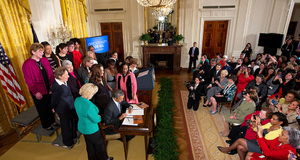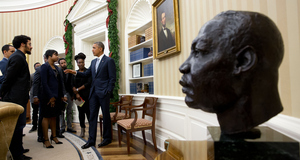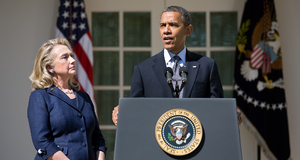The Obama PresidencyWhy Taking the White House Online Does Not Make It More Accessible To The PublicNew Initiatives at the Start of the Obama PresidencyFrom his first day in office President Obama made public and decisive efforts to define his presidency as the most open and transparent of all the administrations that preceded him. This lends itself easily to President Ford’s messaging efforts to define himself and his administration as starkly different from Nixon and the Watergate Scandal that preceded him. For President Obama, he faced a populace that overwhelmingly disapproved of his predecessor, and in responding to his inclusive, digital-friendly campaign, proved that they were uninterested in the traditional political backgrounds of Hillary Clinton and John McCain. By starting his administration in this manner President Obama was intelligently creating a common thread between the most successful aspects of his campaign and his new position in the White House. President Obama’s launch of the Open Government Initiative directly promoted the increased use of social media in government agencies to promote interaction with the public. It was not until 2012 that the President fully expanded the online presence of the Office of Public Engagement, so one must first consider the original foray into cyber-communication: the Open Government Directive.21 This initiative “requires agencies to increase agency information through their websites and for each open government webpage to include mechanisms for public feedback on the quality of the information and on desired published information.”22 In the first weeks of his first term, President Obama worked to bring his campaign message of a deeply connected constituent-elected official relationship into the Executive Branch. Secretary of State Hillary Clinton began using an online blog to directly share her foreign policy opinions on an accessible online platform. Using “21st century statecraft” became an integral tool in being a functioning member of central government, and the State Department fully committed to the practice. There is some irony that Hillary Clinton led the charge on integrating social media into policy as it is often credited as the main reason she lost to Obama in the Democratic Primary.In tandem with the Open Government Initiative, on his first day as President Obama, he signed two presidential memoranda and an executive order in the efforts to officially define a new period of openness in the White House. He reversed two Bush-era restrictions on the Presidential Records Act to block the power of a past or current President to place holds on their own Presidential records without the approval of the Attorney General. Furthermore, he issued the Presidential Memorandum on the Freedom of Information Act as well as the Presidential Memorandum on Transparency and Open Government. These two new policies restricted the Executive Branch’s power to withhold information from the public and emphasize constructive efforts to improve public access to state records with a 120-day timeframe to implement changes. "President Obama is doing what he said he would do from the campaign trail. He is trying to transform how the public will learn about government decisions and actions, to give us an accountable, democratic, national government. " said Meredith Fuchs, the Archive's General Counsel.23 While these initiatives did not intend to directly tie increased transparency with digital technology, the principles are directly compatible. The emphasis on improving access was consistently exercised through improving government websites, especially their interactive features and social media extensions. By December 2009 each major federal office had created a mandated page within their website that explained their developments following the Open Government Initiative. All of those pages are catalogued on the whitehouse.gov/open website, although many are rudimentary at best.24 Many agencies brought on additional staff to focus exclusively on content creation and web development and at its start the process proved productive. A final step to improve government transparency was the launch of data.gov, a complete online resource for any person to access a vast collection of records from government agencies. The White House Office of Management and Budget premiered the heavily anticipated system in mid-2009 with the first ever federal Chief Information Officer Vivek Kundra at the helm. The site launched in a beta format that compiled data from various entities into one searchable site. As of May 21, 2009 there were twenty-six federal agencies that had contributed to data.gov, these appeared carefully chosen for the least amount of controversy. The National Oceanic and Atmospheric Association released weather data records while the Federal Bureau of Investigation was listed as a contributor but did not provide any raw data at the start.25 Additionally, critics were quick to point out that a private pre-existing data collection site, USGovXML.com had significantly more data sets available at launch time.26 Since then however, data.gov has grown exponentially, now containing over a half-million datasets that the site’s “evangelist” director claims will one day “help predict the future by allowing us to map outbreaks of disease or track the course of climate change.”27 Indeed in March of this year, President Obama launched climate.data.gov to provide a succinct information center to analyze climate change data and format it in an easily understood and accessible manner, with a suite of apps to follow. Yet creating the most open and transparent United States presidency in history has not been the great success expected at the start of Obama’s first term. In September 2014, following his speech at the United Nations General Assembly Open Government Partnership meeting, the President was mocked for his continued promotion of his own open administration on a world stage. “This is the most restrictive and most message-controlling, most manipulative, and often hostile administration that I’ve seen since the Nixon administration”28 said former Washington Post executive editor Len Downie. The focus on sharing government data with the public has been dwarfed by the growing issue of personal data collection practices by the federal government itself. While that is a topic for further research it is an interesting dichotomy to consider. For all the effort put into engaging the public, the results have been far from the outstanding victory of the 2008 Obama campaign. Why is the White House so incompatible with the tremendous communicative power of the Internet and social media? The Office of Public LiasonThe Office of Public Liaison was overhauled at the very start of President Obama’s first term. While the division was still responsible for communicating the interests of various groups it’s renaming was an effort to promote the notion that the White House was beholden to the interests of the citizenry, not exclusively to those of corporations and other power-wielding conglomerates. “During his inauguration, President Obama stated very clearly that ‘our commitment to openness means more than simply informing the American people about how decisions are made. It means recognizing that government does not have all the answers, and that public officials need to draw on what citizens know.’”29 To that end, the Office of Public Engagement (OPE) became the public-facing window into the White House and into the governance process. In this manner, the Obama administration communicated to the public that lobbying was not the sole means of drawing the attention of elected officials to the concerns of the public. Similarly, it wasn’t a matter of who had the financial means to have their voices heard in government. This public relations strategy however, was merely that, strategy. Despite efforts to prove contrary, President Obama has been as open and available to special interests as the Presidents before him. While the new OPE received some media attention, the stimulus package and the passage of the Affordable Care Act took up the overwhelming majority of attention in President Obama’s first term. Particularly, the problematic launch of healthcare.gov served as an antithesis to the media-savvy image that the Obama administration had so carefully cultivated. The promises for the Healthcare website were considerable given the high failure rate of most large Information Technology projects. When at launch time the site crashed repeatedly, lending an unprofessional quality to a policy that the American public was already uneasy about, the hopeful future of ‘Obamacare’(as it had come to be called) crashed with it. The Obama administration had already taken a large leap of faith in focusing much of its political capital on the passage of a universal healthcare bill and creating an online marketplace in which to carry out what would become his signature piece of legislation. Actual signup numbers fell disastrously below targets and the site was rendered useless for weeks. The Financial Times had a particularly scathing review of the failure stating, “in their effort to build an IT system to implement Obamacare, the U.S. Department of Health and Human Services (HHS) was trying to do the same thing as the USSR’s Gosplan agency: elicit coordinated, purposeful action from a collection of entities that don’t know each other, don’t trust each other, have conflicting objectives, and face diverging incentives.” We The PeopleTo set a new tone for his second term, President Obama made another visible move towards improving transparency by launching the “We The People” website in 2011. The Office of Public Engagement website moved to the domain whitehouse.gov/engage which became the new homepage for public relations with the American people. The rollout of the program was directly in line with the boost of digital engagement that led President Obama to victory in 2012, once again at the cost of an opponent with a lesser online presence, Governor Mitt Romney. The keystone of this website launch was the online petition form that allowed any visitor to create a petition and make it available for signature. Once a petition on the site reaches 100,000 signatures within thirty days it is guaranteed that the White House address it, previously this threshold was 5,000 which was quickly changed to 25,000 and it has been raised over the last two years. The process supports the Obama administration’s open government policies and underscores the “We The People” title affirming the power and authority of the citizenry in advancing meaningful legislation. Overwhelmingly the site has been used to advance petitions that are very unlikely to receive any meaningful response from the federal government. Some notable recent examples include a petition to deport teen pop sensation Justin Bieber back to Canada and to cancel the cable television program “19 Kids and Counting” based on the moral beliefs of the family depicted. Needless to say these were not the intended results of the site and in fact no petition even those more appropriate, such as one to require all on duty police officers to wear body cameras in response to the shooting of Michael Brown by a police office in Ferguson, Missouri, have failed to achieve any meaningful legislative response from the Obama administration, although in this particular case President Obama did communicate his verbal support.30 The launch of “We The People” made headlines as the administration released an announcement via YouTube that portrayed the President and First Lady tweeting for the first time and emphasizing how real people were engaging with the executive officer in meaningful and productive ways.31 By rebranding the Office of Public Engagement with a new website geared towards the public, President Obama emphasized his ongoing message of transparency and accessibility to the public. No more was the former Office of Public Liaison concerned only with communicating special interests “We The People” and its accompanying social media rollout was designed to modernize the White House and put power back in the hands of everyday citizens without needing to go through an umbrella group with lobbying power. “Many petitioners complain that, even with the more serious petitions, the administration has issued boilerplate responses with little opportunity for follow-up. One petition asked the White House to take the petitions more seriously; that one garnered 37,000 signatures.”32 While some senior staff behind the platform believe that even the mostly inane products of the site support the thesis of openness and contribute to active democracy, most Americans have not benefitted from this avenue being opened. This begs the question, was the website holistically well intentioned, and merely faltered in its execution? Or are more serious critics to be believed and the site itself was created to perpetuate the illusion that the President is concerned with direct democracy while lobbyists and special interests continue to hold all the cards behind the scenes? Surely some of both possibilities are occurring.Continued on Next Page » Suggested Reading from Inquiries Journal
Inquiries Journal provides undergraduate and graduate students around the world a platform for the wide dissemination of academic work over a range of core disciplines. Representing the work of students from hundreds of institutions around the globe, Inquiries Journal's large database of academic articles is completely free. Learn more | Blog | Submit Latest in Political Science |


















